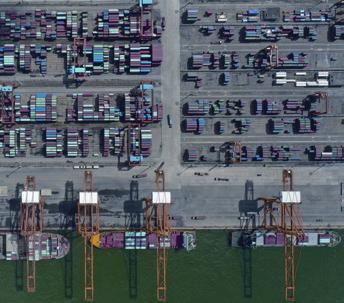2019’s Top 10 Business News Stories

1 Individual Income Tax Law Reform
The reformed Individual Income Tax Law came into force on January 1.
It raised the minimum threshold for personal income tax exemption from 3,500 yuan ($513) to 5,000 yuan ($733) per month. Special deductions were added for expenses like caring for elderly parents, childrens education and continuing education. Treatment for serious diseases also came under exemption as well as housing loan interests and rents.
With the new policy in place, urban residents with a monthly income of 10,000 yuan ($1,466) can enjoy more than 60 percent tax cuts.
The individual income tax is the third major contributor to overall national tax revenue, following value-added tax and enterprise income tax.

2 Foreign Investment Law
The national legislature on March 15 passed the Foreign Investment Law, which will go into effect on January 1, 2020.
The law aims to improve transparency in foreign investment policies. It ensures domestic and foreign enterprises are subject to a unified set of rules and compete on a level playing field.
Subsequently, regulations and rules were made to support the new law. The negative list for foreign investment that spells out the sectors and businesses out of bounds for both foreign and domestic investors was shortened. An updated list issued in November contains 131 administrative measures on investment, down 13 percent from the 2018 version.

3 5G Commercial Licenses
The Ministry of Industry and Information Technology issued commercial licenses for 5G on June 6. Three major telecom operators—China Telecom, China Mobile and China Unicom—and China Broadcasting Network received the first batch of licenses.
The next-generation tech is expected to be at least 10 times faster than 4G. The huge capacity to connect things will enable smart factories, selfdriving vehicles and other applications.
Miao Wei, Minister of Industry and Information Technology, said the number of 5G base stations in China is expected to reach 130,000 by the end of 2019.
China is set to become the worlds largest 5G market by 2025, with 460 million 5G users, according to a forecast by the industry group Global System for Mobile Communications Association.

4 Capital Market Boost
The Shanghai-London Stock Connect program opened for trading on June 17, a new step to open up Chinas financial market to the world.
Under the mechanism, Shanghai-listed companies can list on the London Stock Exchange via a global depositary receipt, while British companies can issue Chinese depositary receipts on the Shanghai Stock Exchange (SSE).
The launch is a major part of the China-Britain pragmatic cooperation in the financial sector, the China Securities Regulatory Commission said.
In addition, Chinas Science and Technology Innovation Board or STAR Market, a new board at the SSE and a new stock venue for tech companies, started trading on July 22.
The launch of the STAR Market is seen by analysts as a milestone event in the development of Chinas capital market. In the long run, it will likely have a significant impact on the A-share markets valuations and investment choices.

5 AIIB Gets 100 Members
The Asian Infrastructure Investment Bank (AIIB)s board of governors approved membership for three African countries, Benin, Djibouti and Rwanda, at their annual meeting in Luxembourg on July 13. This took the total number of AIIB members to 100.
Since January 2016, the AIIB has provided$8.5 billion in loans for 45 projects in 18 member countries, many of them in renewable energy and green infrastructure. It has received the highest credit ratings from three top rating agencies, Standard & Poors, Moodys and Fitch Ratings.
By the end of 2018, the banks total investment had reached $7.5 billion, up from $4.2 billion a year earlier, according to its annual report.
The construction of its headquarters in Beijing was completed on October 24.

6 More Chinese Firms in Fortune Global 500
Fortune on July 22 announced its new list of Global 500 companies where Chinese firms number reached 129, surpassing the U.S. for the first time. The number of U.S. companies on the list was 121.
Chinas largest state-owned oil and gas company Sinopec climbed up one spot higher to second place thanks to sharp gains in both revenue and profits in 2018.
China National Petroleum Corp. bagged fourth spot with $392.98 billion revenue in 2018, followed by State Grid with $387.06 billion. Three Chinese companies were included in the top 10 and mainly engaged in natural resources.
With $69.85 billion revenue, JD.com continued to lead Chinese Internet companies, reaching 139th spot on the list. Alibaba, whose revenue reached$56.15 billion, was the company with the fastest growth rate, jumping 118 spots to 182. Gree Electric Appliances and Xiaomi Corp. debuted on the list. Nine-year-old Xiaomi became the youngest company among the Global 500.

7 Six New FTZs
Six new pilot free trade zones (FTZs) were approved in August, bringing the total number to 18.
The new FTZs will come up in landlocked Yunnan Province in the southwest; Heilongjiang, a northeasternmost province that is a traditional industry base as well as a major agricultural base; Guangxi Zhuang Autonomous Region in the south; and the coastal provinces of Shandong, Jiangsu and Hebei.
With the new additions, the pilot FTZs now cover all coastal provincial-level regions. It is also the first time that pilot FTZs have been established in border regions.
China started piloting FTZs with Shanghai in 2013. The China (Shanghai) Pilot FTZ expanded with the inclusion of the Lin-gang Special Area on August 20, the second expansion. Teslas gigafactory in China, which attracted over 50 billion yuan ($7.13 billion) of investment, is in Lin-gang.

8 Second Import Expo
The Second China International Import Expo (CIIE) concluded on November 10, with $71.13 billion worth of tentative deals reached for one-year purchases of goods and services. It is a 23-percent rise from the 2018 value.
A total of 181 countries, regions and international organizations attended the expo, and more than 3,800 enterprises exhibited their products and services. The six-day event, themed New Era, Shared Future, attracted more than 500,000 domestic and overseas buyers.
More than 230 companies from all over the world have signed up for the Third CIIE next year.

9 Pork Price Capped
The pork price index began to retreat with multiple measures to stabilize hog production in early November. They include increasing subsidies to restore production, releasing frozen pork reserves and expanding imports.
Prices of pork, a staple meat in China, had been soaring in previous months, mainly affected by the African swine fever and cyclical factors.
The consumer price index (CPI), a main gauge of inflation, rose 4.5 percent year on year in November, mainly driven by soaring pork prices. Pork prices rose 101.3 percent year on year in October, contributing nearly two thirds of the CPI growth that month.

10 Euro Bonds Issued
The Chinese Government issued euro-denominated sovereign bonds worth 4 billion euros ($4.45 billion) on November 5 in Paris to support the development of the city as an international financial center and deepen financial cooperation between China and France as well as China and Europe.
It was the first time China issued euro-denominated sovereign bonds since 2004. The bonds, the largest foreign currencydenominated bond offering of their kind, are expected to fuel more European investment in China.

